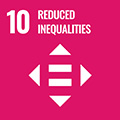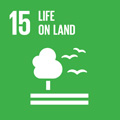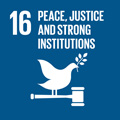- Docente: Sanja Kajinic
- Credits: 6
- SSD: SPS/06
- Language: English
- Teaching Mode: Traditional lectures
- Campus: Ravenna
- Corso: Second cycle degree programme (LM) in International Cooperation on Human Rights and Intercultural Heritage (cod. 9237)
-
from Mar 18, 2025 to May 06, 2025
Learning outcomes
The course aims at offering a challenging approach to the major forces instrumental in the shaping of politics, society and culture in Eastern Europe in the XIX and XX centuries. The research focus includes the analysis of the following areas: The rise of the Nation-State in Eastern Europe National Majorities and Minorities in Eastern Europe Self-determination in Soviet and post-Soviet Times: Drawing National Borders Post-Soviet conflicts: Grey areas and De-facto States At the end of the course, students have basic knowledge and critical skills in the above mentioned research areas, and they are ready to undertake scientific researches on the contemporary social and political dynamics characterizing Eastern European countries.
Course contents
The course will focus on contemporary history of Eastern Europe, following the sociopolitical and cultural changes of its 20th and 21st centuries. The introductory approach is through questioning conceptualizations of symbolic geographies that have created the geo-historical categories of Eastern/Western, Central and Southeastern Europe themselves, and their implications for potential critical readings of political and cultural history of these regions. The theoretical framework of the course will draw on the theories of nation and state building as well as the contextualization of minority protection in the complex histories of Eastern Europe. Additional thematic concerns will regard the dynamics of nationalism, ethnic belonging, border changes and conflicts, migration, language and identities.
The course work will draw on three major conceptual approaches (symbolic geographies of Eastern Europe, nation and state building, and the protection of minorities) to follow their implication for the history of this space. Special focus will be on the history of Central and Southeastern Europe, while a parallel thread will follow the history of the USSR and of post-Soviet countries. Each lesson is intended to bring together theoretical and historical reading with a close reading of chosen primary source(s) or of especially relevant secondary sources. Some lessons will also include viewing of parts of selected documentary films and their discussion.
Course outline
Lesson 1
Introduction to the course - Symbolic geography of Eastern Europe
Introductory texts:
Wolff, Larry. Introduction. In: Inventing Eastern Europe: The map of civilization on the mind of the Enlightenment. Stanford University Press, 1994. Pp. 1-17. Available at: https://books.google.it/books?hl=it&lr=&id=JHm2c1jg2mAC&oi=fnd&pg=PR1&dq=larry+wolff+inventing+eastern+europe&ots=dbyDfnzDGy&sig=gQxnz1VHI9hV_ebcl8zuE4xt6eI&redir_esc=y#v=onepage&q=larry%20wolff%20inventing%20eastern%20europe&f=false
In-class work: The Prokudin-Gorskii Photographies (see Virtuale).
Excerpts from a documentary film, discussion and group-work.
Lesson 2
Defining nations
Introductory reading: Florian Bieber. Introduction. In: Debating Nationalism: The Global Spread of Nations, Bloomsbury Academic, 2020. Pp. 1-21. Partially available at: https://books.google.it/books?id=Kt7FDwAAQBAJ&printsec=frontcover&hl=it&source=gbs_ge_summary_r&cad=0#v=onepage&q&f=false
Potential presentation: Hobsbawm, Eric. Introduction: Inventing traditions. In: (E. Hobsbawm and Terence Ranger, eds). The invention of tradition. Cambridge University Press, 2012. Pp. 1-15. Available at: https://books.google.it/books?hl=it&lr=&id=IckLAQAAQBAJ&oi=fnd&pg=PA1&dq=hobsbawm+invention+of+tradition&ots=9kVchOGgfA&sig=xkpZusJ9QCT1xA0n3EI00_tSFJg&redir_esc=y#v=onepage&q=hobsbawm%20invention%20of%20tradition&f=false
OR
Anderson, Benedict. Introduction. In: Imagined communities: Reflections on the origin and spread of nationalism. Verso, 1983. Pp. 1-9.
Lesson 3
History of Eastern Europe through the lens of theories of nation and state-building
Introductory reading: Florian Bieber. chapter 3, The spread of nationalism and nation-states in Europe. In: Debating Nationalism: The Global Spread of Nations, Bloomsbury Academic, 2020. Pp. 35-67.
In class analysis: Excerpts from the Nation-building in SEE Workbook (see Virtuale for primary sources).
Potential presentation: J. Smith. Introduction: the prison-house of nations. In: Red Nations: The Nationalities Experience in and after the USSR, Cambridge University Press, 2013. Pp. 1-17. Available at: https://issuu.com/cambridge.org.uk/docs/red_nations
Excerpts from a documentary film and discussion.
Lesson 4
Modernity and development in Eastern Europe
Introductory reading: Bianchini, Stefano. Development and backwardness: the social origins of Eastern European politics. In: Eastern Europe and the challenges of modernity, 1800-2000. Routledge, 2015. Pp. 25-42. Available at: https://books.google.it/books?id=bl_rBgAAQBAJ&printsec=frontcover&dq=stefano+bianchini+eastern+europe&hl=it&newbks=1&newbks_redir=0&sa=X&redir_esc=y#v=onepage&q=stefano%20bianchini%20eastern%20europe&f=false
Potential presentation:
J. Smith. Chapter 2: Dispersal and reunion: revolution and civil war in the borderlands. In: Red Nations: The Nationalities Experience in and after the USSR, Cambridge University Press, 2013. Pp. 17-53. Partially available at: https://books.google.it/books?id=gfJ4AAAAQBAJ&printsec=frontcover&hl=it&source=gbs_ge_summary_r&cad=0#v=onepage&q&f=false
Lesson 5
Protection of minorities
Introductory text: Mazower, Mark. Chapter 2: Empires, Nations, Minorities. In: Dark continent: Europe's twentieth century. Vintage Books, 1998. Pp.41-76.
and
Minority Rights Group International report (choose 1, at: https://minorityrights.org/regions/central-eastern-europe/ )
In Class analysis: Lenin "On the question of nationalities”, or excerpts from the Balkan Wars Workbook (see Virtuale for primary sources).
Potential presentation: J. Smith. Chapter 3: Bolshevik nationality policies and the formation of the USSR: the Bolsheviks dispute national policy. In: Red Nations: The Nationalities Experience in and after the USSR, Cambridge University Press, 2013. Pp. 53-73.
Excerpts from a documentary film and discussion.
Lesson 6
Social, economic and political consequences of the WWI
Introductory text: Bianchini, Stefano. The “peasant state”: ideology and politics of agrarian movements in Central-Eastern Europe between the two world wars. In: Eastern Europe and the challenges of modernity, 1800-2000. Routledge, 2015. Pp. 64-85.
Potential presentation: J. Smith. Nation building the Soviet way. In: Red Nations: The Nationalities Experience in and after the USSR, Cambridge University Press, 2013. Pp. 73-97.
Lesson 7
WWII and its consequences on minorities
J. Smith. Chapter 6: The Great Patriotic War and after. In: Red Nations: The Nationalities Experience in and after the USSR, Cambridge University Press, 2013. Pp. 122-147.
In Class analysis: Excerpts from the Nation-building Workbook 1, or Covenant of the League of Nations; or the UN Charter (see Virtuale for primary sources).
Potential presentation: J. Smith. Chapter 7: Deportations. In: Red Nations: The Nationalities Experience in and after the USSR, Cambridge University Press, 2013. Pp. 147-163.
Excerpts from a documentary film and discussion.
Lesson 8
Protection of minorities and international organizations
Introductory text: Mazower, Mark. Chapter 7: A Brutal Peace, 1943-49. In: Dark continent: Europe's twentieth century. Vintage Books, 1998. Pp. 212- 250.
Potential presentation: Antonio Ricci. From Asylum “in History'' to Asylum in “International Law''. In: Undesired guests. The Right of asylum 70 years after the Un Refugee Convention. Idos, Rome. Pp. 57-70.
Lesson 9
From the Cold War to Dissolution
Introductory text:
Bianchini, Stefano. Between otherness and globalization: “real socialism”, modernity and Gorbachev. In: Eastern Europe and the challenges of modernity, 1800-2000. Routledge, 2015.Pp. 150-188.
In Class discussion: Excerpts from the Cold War workbook; the Dayton Peace Agreement; the Aral Sea IFAS reports (see Virtuale for primary sources).
Potential presentation: Florian Bieber. Ethnic conflict. In: Debating Nationalism: The Global Spread of Nations, Bloomsbury Academic, 2020. Pp. 129-159.
Excerpts from documentary films and discussion.
Lesson 10
Beyond nationalism, new nationalisms, new minorities in Eastern Europe
Introductory text: Introduction and discussion of “Borderland” and Krasnogruda. In: Golubiewski, Mikolaj, Joanna Kulas, and Krzysztof Czyżewski, eds. A Handbook of Dialogue: Trust and Identity. Wydawnictwo Pogranicze, 2011. Pp. 3-14; 390-397.
Potential presentation: J. Smith. Nation-making in the post-Soviet states. In: Red Nations: The Nationalities Experience in and after the USSR, Cambridge University Press, 2013. Pp. 282-322.
Lesson 11
Post-communist transitions and the hybridity of identities in new East Europe
Introductory text: Ramet, Sabrina P., and F. Peter Wagner. "Post-socialist models of rule in Central and Southeastern Europe." In: (Ramet and Hassenstaab, eds.). Central and Southeast European politics since (1989): 26-57. Available at: https://books.google.it/books?hl=it&lr=&id=r9GoDwAAQBAJ&oi=fnd&pg=PR9&dq=ramet+hassenstab&ots=ZKOdw8QLp5&sig=i9ZNCUi0EE_vf-Mwg1Gcn0OT2CQ&redir_esc=y#v=onepage&q=ramet%20hassenstab&f=false
In Class analysis: environmental activism - comparative case studies (hydro plants on Balkans’ last wild rivers); Economist World Democracy Index 2024; or ILGA country reports on LGBTQI+ human rights; or Ethnologue country language reports; last primary sources on nation-building
Potential presentation: J. Smith. The orphans of the Soviet Union. In: Red Nations: The Nationalities Experience in and after the USSR, Cambridge University Press, 2013. Pp. 322-358.
Lesson 12
East Europe of today
Introductory text: Freedom House World Democracy report (https://freedomhouse.org/report/freedom-world )
Inclass: wrapping up the course, and discussing research paper topics and issues
Readings/Bibliography
For attending students:
Compulsory Readings (choose 2 books):
Bianchini, Stefano. Eastern Europe and the challenges of modernity, 1800-2000. Routledge, 2015.
Florian Bieber, Debating Nationalism: The Global Spread of Nations, Bloomsbury Academic, 2020.
Jeremy Smith, Red Nations: The Nationalities Experience in and after the USSR, Cambridge University Press, 2013.
Source material analyzed during lessons from (available on Virtuale):
Neven Budak and Alexei Kalionski. The Cold War. Chapter II: The Cold War. CDRSEE, Thessaloniki, 2016.
MIRELA-LUMINIŢA MURGESCU (ed.), Nations and States in Southeast Europe. CDRSEE, Thessaloniki, 2009.
Valery Kolev and Christina Koulouri (eds.), The Balkan Wars. CDRSEE, Thessaloniki, 2009.
For non-attending students:
Compulsory Readings (choose 2 books):
Bianchini, Stefano. Eastern Europe and the challenges of modernity, 1800-2000. Routledge, 2015.
Florian Bieber, Debating Nationalism: The Global Spread of Nations, Bloomsbury Academic, 2020.
Jeremy Smith, Red Nations: The Nationalities Experience in and after the USSR, Cambridge University Press, 2013.
Source material analyzed during lessons from (Available on Virtuale; prepare several selected sections for the oral exam):
Neven Budak and Alexei Kalionski. The Cold War. CDRSEE, Thessaloniki, 2016.
MIRELA-LUMINIŢA MURGESCU (ed.), Nations and States in Southeast Europe. CDRSEE, Thessaloniki, 2009.
Valery Kolev and Christina Koulouri (eds.), The Balkan Wars. CDRSEE, Thessaloniki, 2009.
The non-attending students should also choose 1 elective book from the following (and prepare 3-4 chapters from it):
Czyżewski, Krzysztof (ed). A Handbook of Dialogue: Trust and Identity. Wydawnictwo Pogranicze, 2011.
Hroch, Miroslav. European Nations: Explaining their Formation. Verso Books, 2015.
Mazower, Mark. Dark continent: Europe's twentieth century. Vintage Books, 1998.
Ramet, Sabrina P., and Christine M. Hassenstab, eds. Central and southeast European politics since 1989. Cambridge University Press, 2019.
Timothy Snyder. Bloodlands: Europe between Hitler and Stalin. New York: Basic Books, 2010.
Teaching methods
Introductory lectures, seminar work, presentations, student course work and group discussions, individual student presentations of the topic of their research paper.
If you can, bring a laptop to Tuesday (3 hour) classes, for in-class work.
Be informed that the use of generative artificial intelligence is considered a form of plagiarism.Assessment methods
Assessment methods for attending students
The grade for the course will take into account class participation of a student, which together with one in-class presentation will amount to 30% of the final grade.
The intermediary step before submitting the research paper for the final exam is the writing of a book summary (or, if preferred, a synopsis). This book ‘synopsis’ corresponds to one of the 2 books chosen by the student for this exam. The book ‘synopsis’ deals with all of the book chapters that were not discussed in class (either as mandatory reading for lessons or as a presentation). This assignment is approximately 2 pages (500 words). Within the book ‘synopsis’, each chapter overview is around a paragraph and is guided by a (research) question - this method and other clarifications will be talked about in class in detail.
The 70% of the final grade will depend on a research paper submitted by the student. The paper should be on a topic agreed upon with the lecturer, of around 2000 words, and combining theoretical and historical debates discussed in the course together with the student’s original research on the chosen research question.
It is advisable to prepare the book ‘synopsis’ before starting to work on the research paper and upoad it to Virtuale at any time when you are ready. Instead, the final research paper is to be submitted via the Compilatio link (provided by the teacher) at the time of the exam date.
An outline of the assessment steps:
-
verbal assessment and class participation (30%, combined in-class work and 1 presentation)
-
intermediary step (to be completed before writing the paper): read the 2 mandatory exam books (of your choice out of 3) and upload 1 short book synopsis to Virtuale
-
final exam: submit a research paper (70% of the final grade)
Assessment methods for non-attending students
For non-attending students, the grade will consist of 50% on a research paper, and 50% on an oral exam (or alternatively on 3 book synopses), based upon 3 mandatory readings for non-attending students and additional primary sources (available on Virtuale). The paper should be on a topic agreed upon with the lecturer, of around 2000 words, and combining theoretical and historical debates dealt with in the course together with the student’s original research on the chosen research question. Please submit the paper at least 3-4 days before the exam session deadline, so to be able to organize the oral exam, if needed.
The oral exam will be based on six questions (two questions per each of three books required) aimed to get an insight into most important debates covered by the course and evaluate student’s critical thinking and verbal expression applied to the course subject matter. Alternatively, the student may choose to submit 3 book synopses based on 3 required books for this exam. The book ‘synopsis’ analyzes the book chapters of each of the 3 books, and is approximately 2 pages (500 words). In this case, upload the 3 synopsis on Virtuale before the exam deadline.
The established grading criteria are as follows:
The ability of the student to achieve a coherent and comprehensive understanding of the topics addressed by the course, to critically assess them and to use an appropriate language will be evaluated with the highest grades (A = 27-30 con lode).
A predominantly mnemonic acquisition of the course's contents together with gaps and deficiencies in terms of language, critical and/or logical skills will result in grades ranging from good (B = 24-26) to satisfactory (C = 21-23).
A low level of knowledge of the course’s contents together with gaps and deficiencies in terms of language, critical and/or logical skills will be considered as ‘barely passing' (D = 18-20) or result in a fail grading (F).
Teaching tools
Audio and video materials, additional textual documents and maps, media analysis.
Students with a form of disability or specific learning disabilities (DSA) who are requesting academic adjustments or compensatory tools are invited to communicate their needs to the teaching staff in order to properly address them and agree on the appropriate measures with the competent bodies.
Office hours
See the website of Sanja Kajinic
SDGs




This teaching activity contributes to the achievement of the Sustainable Development Goals of the UN 2030 Agenda.
